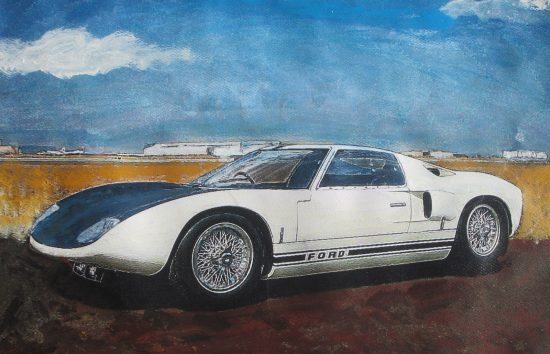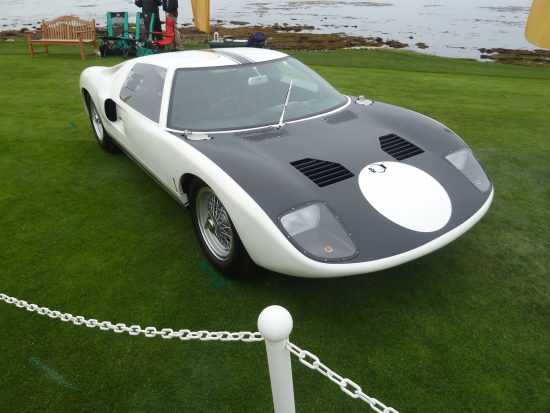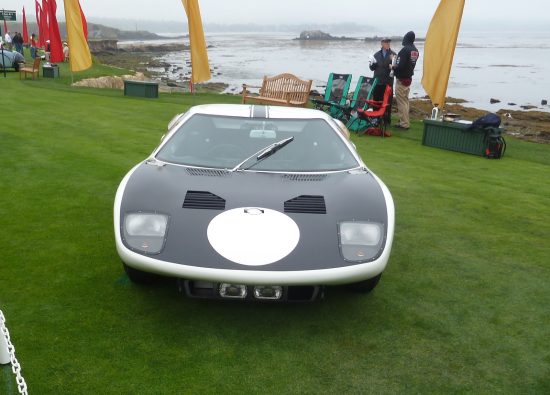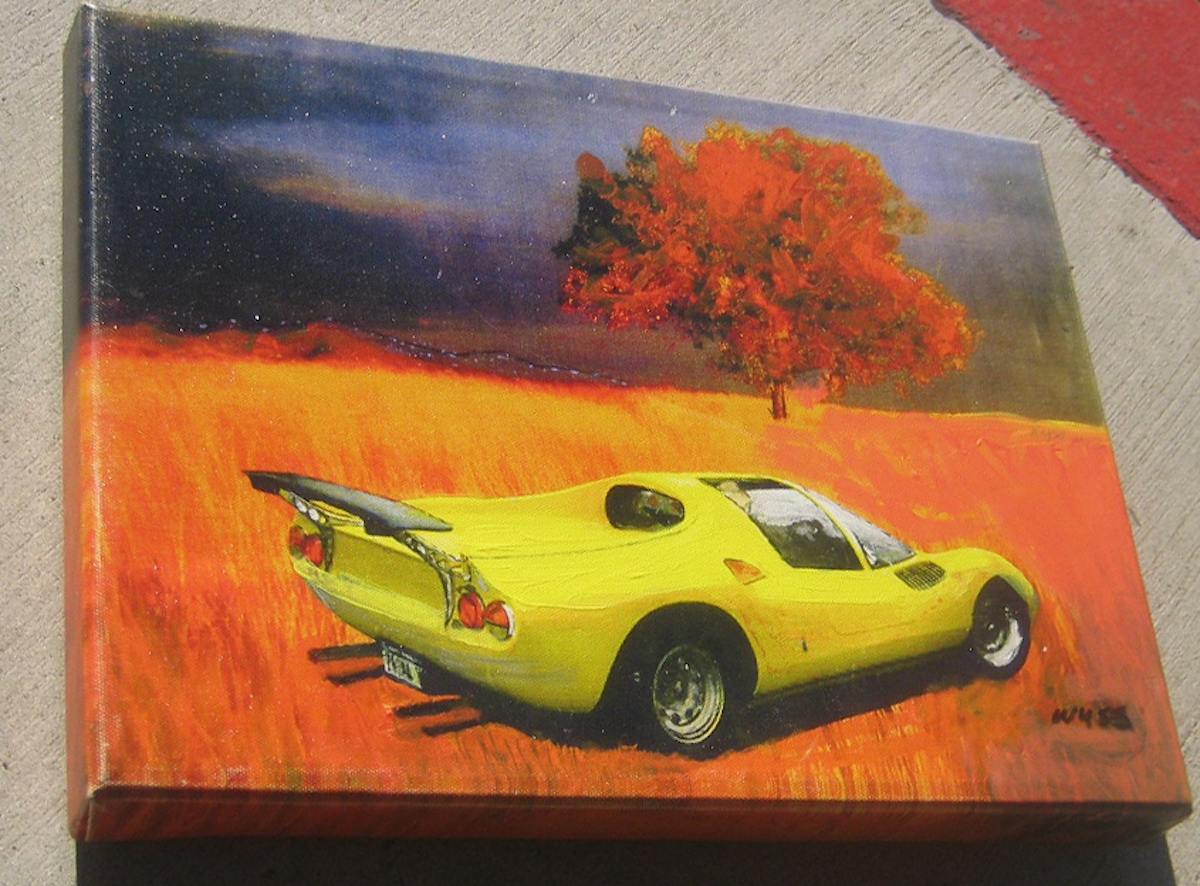Oh, they showed one at Pebble Beach. But….
by Wallace Wyss –
So there I was, at the Pebble Beach Concours d’Elegance this past August, looking forward to seeing the Ford GT40s because I knew Ford was going to great effort to have one of each model designed and built, culminating in the ones that won Le Mans.
And they did not disappoint except…well, real tiny, (had to adjust my glasses) on a sign below the first one in the line-up, the needle nose one, it said “Tribute Car.”
Which means, egad, this car was constructed in modern times.
Now I happen to remember when the Ford GTs were racing at LeMans, right from the first year 1964. And I know that first year car had a needle nose, which no doubt led to huge nose lift (some racers admitted decades later that, past 170 mph the front could be a foot off the ground!).
The GT40 came about of course because Enzo slammed the door in Henry Ford II’s emissaries collective faces after negotiations for Ford to buy Ferrari fell apart around ’62 or ’63.
So HFII gave orders to his minions to build their own damn GT car. And they asked Shelby, already on board making Cobras, who he should choose and Shelby skipped over Colin Chapman (who had irritated Ford by taking an outsize amount of credit for the Indy racing car he built for them) and named Eric Broadley.
Ford even bought the first two Lola GT chassis to use as mules to test GT40 parts. Former Aston Martin racing manager John Wyer put in charge of the development team and Roy Lunn, a Brit working in Detroit, the same man who had engineered the mid-engined 1962 Mustang 1 concept car, was sent back to Blighty to aid in development.
The first test drivers were Bruce McLaren and Roy Salvadori and later on John Willment (later Sir John). The GT40’s frame was a monocoque constructed of light-gauge steel. Broadley had wanted aluminum so right from the get-go he didn’t like the way it was going.
It used two fuel tanks in the sills, actually helicopter style rubber bladders, conventional double A-arm independent suspension up front and twin radius arms, lower A-arms and magnesium uprights in the rear. Eleven-inch cast-iron Girling disc brakes were used at all four corners along with Borrani wire wheels and Goodyear racing rubber. The Italian made wire wheels were only used the first year, as they snapped spokes like crazy.
Also lasting less than a year was the Ford supplied all-aluminum 4.2 L Indianapolis engine and the Italian made Colotti gearbox. Ford had thought the engine that did well at Indy would work in a 24 hour race. They were wrong. Shelby threw out the 260, put in an iron block 289, and threw out the dry sump oiling. Hell if it could work in the Cobra…
And the gearbox—was Enzo telling Colotti to sabotage them? Shelby’s guys worked on the gearbox, making over 20 changes. An order was put in for ZF gearboxes but the Germans weren’t hurrying to fill it.
The very first test on a race track resulted in both cars crashing. That’s when it went back to England for the “ducktail spoiler” similar to that added to the 1962 Ferrari 250 GTO after it proved a tad light in the tail.
At Le Mans practice in April ’64 the instability of the car was obvious when Jo Schlesser crashed on the Mulsanne straight and Salvadori rammed into the bank at the end of the straight. This was when LeMans was barely two months away. Sir John put one into the trees at practice at Monza. They had feared the worst, but he walked out, dusting himself off.
After American driver Ritchie Ginther, suggested the rear spoiler, (which he first suggested while at Ferrari) they got the car stable by the Nurburgring 1,000-km race in May. But at that race the rear suspension tore loose.
Eventually, as recounted in many books (including my own co-authored Ford GT40 and the New Ford GT (still available, see below) Ford realized its mistake. John Wyer was a grand old man but, well, old. Shelby was marginally younger but more aggressive. So Shelby was handed the job of correcting the car’s flaws after Wyer’s losing year in ’64 and he deepened the nose, changed the front hot air exhaust vents, changed the headlight positioning, changed the gearbox to a ZF, the wheels to solid wheels, and even then it couldn’t catch the Ferraris until 1966, when Fords crossed the finish line at Le Mans in positions 1,2,3.
Now the car shown at Pebble was evidentially built anew, many decades later, and is the subject of a book itself.
I kind of wish, for the sake of history, that ol’ 104, one of the surviving Ford GTs from 1964, could have been retrofitted with the old needle nose it was born with but the owners and restorers thought it more appropriate to show it in the body style it was raced in ’65. That’s the way it is when restoring race cars, if they had a lot of races, you have to pick the way the car looked at one race as the most representative, and go with the way it was equipped at that race.
But I still made a painting of the needle nose, because I want my history as I remember it. Call me nostalgic….
Let us know what you think in the Comments.
THE AUTHOR/ARTIST: Wallace Wyss says inquiries about obtaining a print of this panting can be made on his website WallaceWyssFineArt.com. The book can be ordered by sending an email to Wyss click here.







……………….. because I want my history as I remember it.
Thats a good enough reason Wallace.
A good read and remembrance.